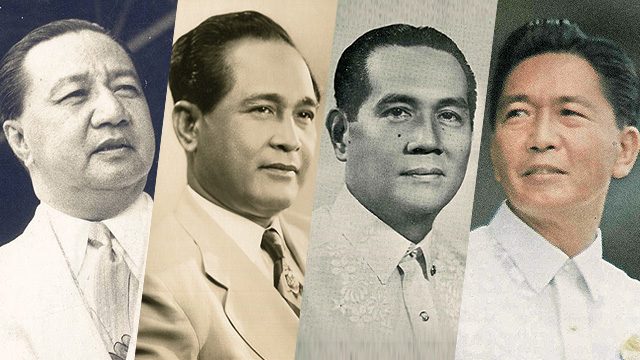SUMMARY
This is AI generated summarization, which may have errors. For context, always refer to the full article.

MANILA, Philippines (UPDATED) – In a surprise burial that shocked the nation, the late dictator Ferdinand Marcos was laid to rest alongside the country’s heroes, martyrs, and former presidents.
Past noon on Friday, November 18, Marcos was buried at the Libingan ng mga Bayani (Heroes’ Cemetery) with full military honors, 30 years after Filipinos staged a popular uprising to overthrow the dictator and end his 21-year rule marked by widespread corruption and human rights atrocities.
At the Heroes’ Cemetery, Marcos was given a 21-gun salute as part of the military honors for the late strongman. His family had requested “simple and private” funeral rites; members of the media – who had learned about the burial only an hour before – were blocked from entering the cemetery. (READ: Behind the scenes: 12 hours to prepare for Marcos burial)
Marcos was laid to rest beside the graves of 3 other former presidents, making him the 4th to be buried at the heroes’ cemetery.
ELPIDIO QUIRINO
November 16, 1890 – February 28, 1956
Before ascending to the presidency, Elpidio Quirino was a member of the House of Representatives and a Philippine senator. He was part of the Philippine independence mission to Washington DC that helped secure the passage of the Tydings-McDuffie Act, which set the date for Philippine independence. Quirino was also one of the key figures that drafted a constitution for the new Philippine Commonwealth.
In 1946, Quirino was elected vice president. He assumed the presidency in April 1948 following the sudden death of then president Manuel Roxas. He was reelected president in November 1949, in polls that were tainted by suspicions of widespread election fraud.
His 6-year term as president was marked by postwar reconstruction and attempts to quell the threat of the communist-led Hukbalahap movement. But his administration was hounded by accusations of corruption – from misappropriation of funds to nepotism – and he was the first Philippine president to face an impeachment complaint in 1949. The complaint was eventually dismissed for lack of merit.
According to historian Ambeth Ocampo, allegations that Quirino had a “golden orinola” (bedpan) and a P5,000 bed in Malacañang were “created by his political enemies in a failed impeachment that damaged his reputation beyond repair.”
Quirino attempted to improve social and economic conditions at the time, signing into law, among others, the Minimum Wage Law of 1951 and the Public School Salary Act of 1948. But these basic social problems remained largely unsolved especially in rural areas. Due to allegations of corruption, Quirino’s defense secretary, Ramon Magsaysay, parted ways with him and ran against him as the Nacionalista candidate in the 1953 elections. Quirino then retired to private life after his loss at the polls.
In February 2016, Quirino’s remains were transferred to the Libingan ng mga Bayani, joining presidents Carlos Garcia and Diosdado Macapagal.
CARLOS P. GARCIA
November 4, 1896 – June 14, 1971
Carlos P. Garcia took over as president following the death of former president Ramon Magsaysay in 1957. He was later elected to a 4-year term.
Before becoming president, Garcia was a schoolteacher, a representative in the Philippine Congress, Bohol governor, and senator. He also joined the guerrilla movement during the Japanese occupation of the Philippines in World War II.
Garcia’s administration was marked by his austerity program which he described as “more work, more thrift, more productive investment, and more efficiency.” His “Filipino First” policy also sought to give the Philippines economic independence and promote domestic industries.
He acted on the Bohlen-Serrano Agreement of 1959, which shortened the term of lease of the US military bases in the country from 99 to 25 years.
A poet, Garcia was given the monikers “Prince of Visayan Poets” and “Bard from Bohol.”
Garcia ran for reelection, but lost to Diosdado Macapagal.
DIOSDADO MACAPAGAL
September 28, 1910 – April 21, 1997
Before becoming president, Macapagal was a lawyer and helped in the anti-Japanese resistance during World War II. He was also member of the House of Representatives, and was Philippine representative to the United Nations General Assembly.
In the 1961 elections, Macapagal ran against Nacionalista president Carlos Garcia, running on an anti-corruption platform. As president, Macapagal sought to lift the Philippine economy. The Philippine peso was placed on the free currency exchange market and exports were encouraged. Under his term, the Philippines’ first land reform legislation was passed. It was also under his term when the date of Philippine independence was shifted from July 4 to June 12.
In 1964, Macapagal faced an impeachment complaint for various offenses, including allegedly using the military to intimidate the opposition. A congressional committee later dismissed the charges.
Macapagal sought reelection in 1965, but was defeated by Ferdinand Marcos.
The controversial Marcos burial comes only a little more than a week after the Supreme Court cleared the legal obstacle blocking the dictator’s burial. In a 9-5 vote, the High Court ruled that there was no law prohibiting Marcos’ burial at the cemetery.
But the controversial burial reopened old wounds, especially for the victims of human rights abuses under the dictator’s iron-fisted rule. Thousands staged rallies across Metro Manila, converging at the People Power Monument along EDSA – the shrine that serves as a memorial of the 1986 revolution that toppled the Marcoses. (IN PHOTOS, VIDEOS: A night of rage, camaraderie, and purpose) – Rappler.com
Add a comment
How does this make you feel?
There are no comments yet. Add your comment to start the conversation.